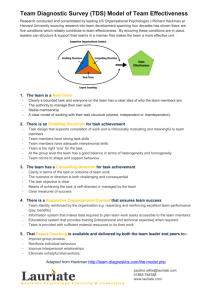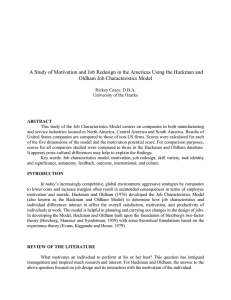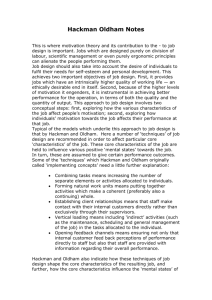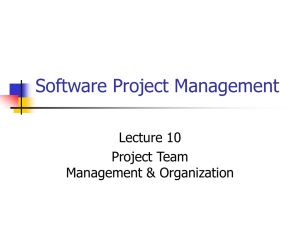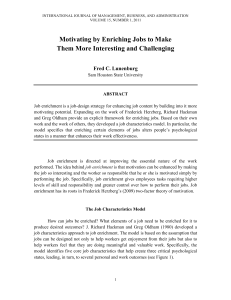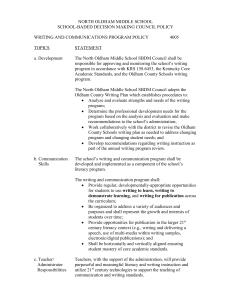An Evaluation Of Motivation in Nicaragua, Guatemala, Mexico
advertisement
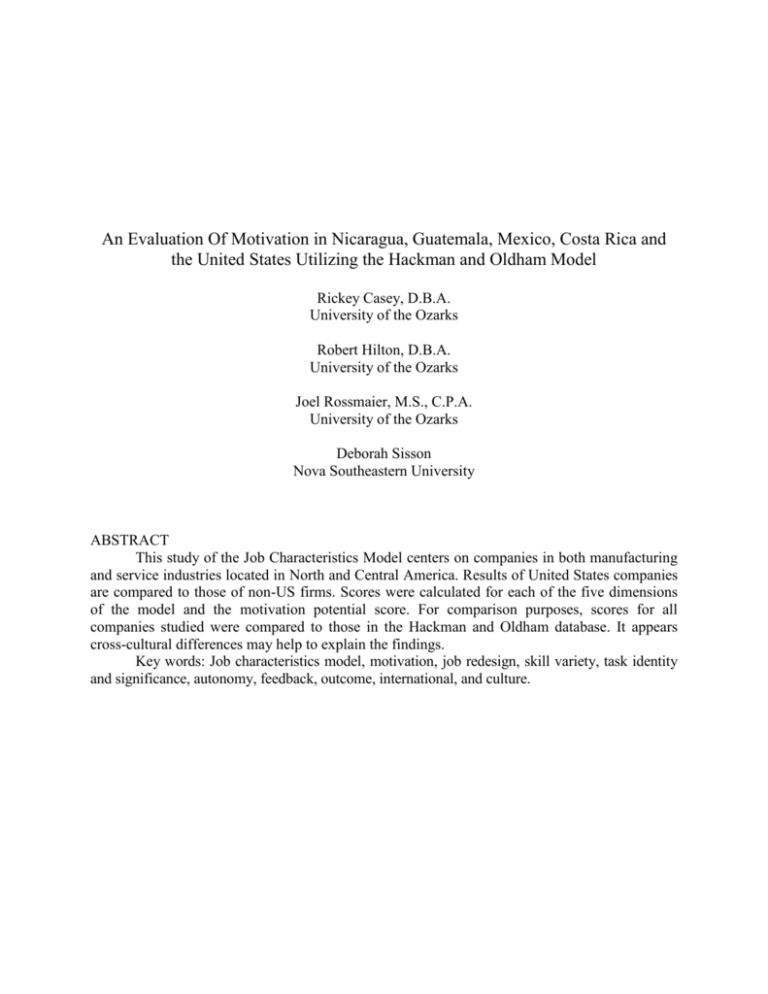
An Evaluation Of Motivation in Nicaragua, Guatemala, Mexico, Costa Rica and the United States Utilizing the Hackman and Oldham Model Rickey Casey, D.B.A. University of the Ozarks Robert Hilton, D.B.A. University of the Ozarks Joel Rossmaier, M.S., C.P.A. University of the Ozarks Deborah Sisson Nova Southeastern University ABSTRACT This study of the Job Characteristics Model centers on companies in both manufacturing and service industries located in North and Central America. Results of United States companies are compared to those of non-US firms. Scores were calculated for each of the five dimensions of the model and the motivation potential score. For comparison purposes, scores for all companies studied were compared to those in the Hackman and Oldham database. It appears cross-cultural differences may help to explain the findings. Key words: Job characteristics model, motivation, job redesign, skill variety, task identity and significance, autonomy, feedback, outcome, international, and culture. INTRODUCTION In today’s increasingly competitive, global environment, aggressive strategies by companies to lower costs and increase margins often result in unintended consequences in terms of employee motivation and morale. Hackman and Oldham (1976) developed the Job Characteristics Model (also known as the Hackman and Oldham Model) to determine how job characteristics and individual differences interact to affect the overall satisfaction, motivation, and productivity of individuals at work. The model is helpful in planning and carrying out changes in the design of jobs. In developing the Model, Hackman and Oldham built upon the foundation of Herzberg's two-factor theory (Herzberg, Mausner and Synderman, 1959) with some theoretical foundations based on the expectancy theory (Evans, Kiggundu and House, 1979). REVIEW OF THE LITERATURE What motivates an individual to perform at his or her best? This question has intrigued management and inspired much research and interest. For Hackman and Oldham, the answer to the above question focused on job design and its interaction with the motivation of the individual. The Hackman and Oldham model was developed to specify how job characteristics and individual differences interact to affect the satisfaction, motivation, and the productivity of individuals at work. The model is specifically used in planning and carrying out changes in the design of work. Several studies have supported the theory of motivation through job redesign (Ford, 1969; Lawler, 1973; Maher, 1971; Meyers, 1970; Special Task Force, HEW, 1973; Vroom, 1964). Studies of job redesign have found that this technique is able to (1) significantly reduce turnover and absenteeism, (2) improve job satisfaction, (3) improve quality of products, and (4) improve productivity and outputs rates (Steers and Porter, 1987). Several researchers started the job redesign movement (Walker and Guest, 1952; Herzberg, 1966; Davis, 1957; Herzberg, Mausner and Snyderman, 1959). Job redesign has become a useful tool in developing ergonomic programs, resulting in increased motivation and fewer injuries (Mier, 1992). Using job redesign to introduce technology into the workplace will be very important in the 1990's for there will be a shift from a tightly controlled management structure with narrowly defined jobs to a style that gives employees satisfaction, thus increasing motivation (Iadipaolo, 1992). Work redesign is a unique approach to motivation and company reorganization for four reasons: (1) work redesign alters the basic relationship between a person and what he or she does in the job; (2) work redesign directly changes behavior, which tends to stay changed; (3) work redesign offers and sometimes forces into one's hands numerous opportunities for initiating other organizational changes; and (4) work redesign, in the long term, can result in organizations that rehumanize rather than dehumanize the people who work in them (Hackman, 1977). The entire concept of job redesign is based upon the theories of motivation and the motivation literature. Motivation may be defined as psychological forces that determine the direction of a person's level of effort, and a person's level of persistence in the face of obstacles (Kanfer, 1990). Or motivation is simply, why people behave as they do on the job. Motivation stimulates people to do things with the use of inducements and incentives. People are motivated to reach an objective only if they feel it is in their best interest to do so (Bernard, 1938). Trends in motivation seem to be in the area of job redesign to determine why people work and what really motivates an employee or manager (Kovach, 1987). The theories of motivation are still being utilized to better understand and motivate people. They have been tested and utilized in a variety of cultures (Geert, 1980). Job performance and its relationship to motivation have continued to be an important issue of study (Katerberg and Vkaym, 1987). Motivation theory has evolved into two distinct categories, content theories and process theories. Content theories focus on the importance of the work itself and the challenges, growth opportunities, and responsibilities work provides for employees. Thus, those theories concern the content of motivation, i.e. the specific needs that motivate and direct human behavior. On the other hand, process theories concern the cognitive processes individuals use in making decisions and choices related to work (Schultz and Schultz, 1998). Consequently, Hackman and Oldham’s Job Characteristics model is a process theory of motivation. Recent studies of the JCM have tended to focus on two general questions: (1) does the model apply to non-manufacturing jobs (e.g., service, sales, health care)? (2) Are there mitigating factors which may apply to work settings outside the United States? Some studies have explored these questions simultaneously. Several recent studies have explored the first question alone. In the United States, the usefulness of the JCM has been validated in studies of information technology professionals (Brown, 2002), public school teachers (Fernandez, 2002), and hospital workers (Casey and Robbins, 2009). Other studies have been conducted outside the U.S., albeit in areas with a similar culture and society. One researcher administered the JDS to hotel workers in the United Kingdom (Lee-Ross, 1998) and to hospital chefs in Australia (Lee-Ross, 2002). In both cases the results indicated that the JCM was valid in a service setting. Several studies have been conducted using the Job Characteristics Model in international settings. A study in Belgium of public service workers found that administrative tasks (more routine and clerical in nature) held less motivating potential than commercial tasks (those tasks more closely associated with accomplishing the mission of the organization), due to lower levels of the core job characteristics (Buelens and Van den Broeck, 2007). A study in Malta focused on the level of motivation of public service workers (PSM); this study found that employees who experience positive job characteristics, as measured by the JDS, have a higher PSM level (Camilleri, 2005). Elanain (2008), in a study of both manufacturing and service companies, found employees are impacted by increasing the provision of the critical job characteristics; employee satisfaction and commitment can be increased and turnover can be decreased as a result. A Netherlands study in the financial services and educational areas found support for the hypothesis that work characteristics are a direct cause of job motivation and satisfaction (Houkes, Janssen, Jonge and Bakker, 2003). Another study proposed that critical job dimensions would be lower for Mauritian workers than for Australian, i.e., work content would be perceived differently due to cultural differences (Lee-Ross, 2005). Using the JDS to measure work content, the author found that Mauritian workers scored lower on all five of the critical job dimensions. Michailidis and Dracou (2011) studied Cyprus sales representatives and found the MPS score was significantly related to three characteristics—educational level, age, and tenure. Educational level and age were inversely related, while tenure was directly related. Millette and Gagné (2008) found support for the hypothesis that the MPS (job satisfaction) was positively associated with autonomous motivation (defined as internal motivation) among volunteers in a health care organization. The authors also found support for the hypothesis that MPS was positively associated with volunteer work satisfaction. Sadler-Smith, El-Kot and Leat (2003) found the work criterion, autonomy, was associated with job satisfaction in a non-Western context (Egypt) through a manufacturing facility study. A study of educational institutions in Germany (Schermuly, Schermuly and Meyer, 2011) found that job satisfaction was highly and inversely related to emotional exhaustion. The authors also found that satisfaction was predicted best by perceived competence of the subjects (in this case, vice-principals of the institution). Among various service workers in Canada, Mexico and the Netherlands, researchers found that job satisfaction is affected by external factors such as cultural influences (Sledge, Miles and van Sambeek, 2011). Wong, Hui and Law (1998) found that overall and intrinsic job satisfaction is reciprocally related to job perception among service workers in China. HYPOTHESES The researchers developed the following hypotheses to determine if a significant difference exists between US and non-US companies. Ho: There is no statistically significant difference among the United States and Non-US survey results. Ha: There is a statistically significant difference among the United States and Non-US survey results. METHODOLOGY A convenience sample of three U.S. companies was selected for study. The sample for the first study was derived from a manufacturing plant in northwest Arkansas, where a total of 192 employees out of a plant population of 1,000 completed the questionnaire on location. A large retail company in Arkansas comprised the second study, where 89 stores were randomly selected out of a population of 1,953 stores. In the second study, 534 employees were surveyed, with a response rate of 62 percent or 330 employees. The researchers conducted a study in the service industry in the United States. The survey was conducted in a hospital with 300 employees, with 89 employees responding. This represented a 30 percent response rate. A random number generator was utilized to determine participants in the study. A convenience sample of five non-U.S. entities was also selected for study. A bank in Nicaragua has a population of 600 with 233 responding. This represented a 39 percent response rate. A Guatemala bank with a population of 380 employees was surveyed. In the survey 152 employees returned the survey representing a 40 percent response rate. The food service company in Nicaragua had 108 surveys completed out of a total of 150. This response rate was high due to the encouragement of the owner, who communicated to the employees that individual responses would be kept confidential. In the survey of 274 small service business owners in Mexico, 175 completed the survey for a 64 percent response rate. In the Costa Rican bank survey, 52 were surveyed and 28 responded for a response rate of 54 percent. All of the studies above utilized the Job Diagnostic Survey (JDS). Employees completed the Job Diagnostic Survey (JDS) instruments which were sealed in envelopes then collected at a central location and returned to the researchers. The survey instrument was scored, with results compared to each other and to the Hackman and Oldham database. A two-tailed t-test was used to determine if a significant difference exists between the samples. The level of significance was placed at <.05. In each case, the researchers obtained the permission of the companies to conduct the surveys. For the non-US sites, the researchers translated the surveys into Spanish and developed a letter explaining the survey and letting the employees know that individual responses would remain anonymous. The survey instrument translation and letter were certified for both the translation of the survey questions as well as the implied intent. INSTRUMENTATION The Job Diagnostic Survey (JDS) is an instrument designed to measure the key elements of the job characteristics theory. The survey measures several job characteristics, employees’ experienced psychological states, employees' satisfaction with their jobs and work context, and the growth need strength of respondents. The instrument has a variety of scales depending on the section. Sections one through five utilize a 7-point scale. Section six utilizes a 10-point scale, and sections seven and eight utilize a 5-point scale. The JDS is designed to be completed by the incumbents of a job or jobs in question-not by individuals outside the job. An instrument designed for the latter purpose is entitled the Job Rating Form (JRF) and is completed only by management personnel. The Job Rating Form uses a 7-point scale for all three sections. The JDS is not copyrighted and, therefore, may be used without the author's permission. However, the researcher did send letters to the authors asking for permission to use the instrument and purchased a copy of the instrument from the Educational Testing Service in Princeton, New Jersey. A short form of the JDS has also been developed. It excludes measures of the experienced psychological states and uses fewer items to measure other key variables in the job characteristics theory. The long form was used for this research. RELIABILITY OF THE INSTRUMENTS The Job Diagnostic Survey is intended for use in (a) diagnostic activities to determine whether (and how) existing jobs can be improved to increase employee motivation, performance, and satisfaction; and (b) evaluation studies of the effects of work design. Since the JDS was originally published (Hackman and Oldham, 1974 and 1975), the instrument has been used in many organizations and subjected to several empirical tests (Cathcart, Goddard, and Youngblood, 1978; Dunham, 1976; Dunham, Aldag and Brief, 1977; Oldham, Hackman and Stepina, 1979; Pierce and Dunham, 1978; Stone, Ganster, Woodman and Fuslier, in press; Stone and Porter, 1977; Barr and Aldag, 1978). Experience with the JDS, and studies of its properties, have highlighted a number of limitations and suggest several cautions in using the JDS survey instrument (Hackman and Oldham, 1980). The Job Characteristics, as measured by the JDS, are not independent of one another. When a job is high on one characteristic (such as skill variety), it also tends to be high on one or more others (such as autonomy and/or feedback). The positive intercorrelations among the job characteristics may reflect problems in how they are measured in the JDS. Alternatively, it may be that most well-designed jobs are high on most or all of the job characteristics, and jobs that are poorly designed tend to be low on most or all of the job characteristics. Hackman and Oldham are not certain if it is an instrument problem or an ecological phenomenon to over interpret JDS scores for any single job characteristic considered. The developers of the instrument suggest that it is preferable to simply add the scores of the five motivating job characteristics to arrive at an overall estimate of formula for the motivating potential score (MPS) rather than to compute scores individually. The advantage of the MPS score is that it derives directly from the motivational theory on which the JDS is based. The range for the MPS is 1 (lowest) to 343 (highest). Consequently, jobs with high MPS scores are more likely to motivate workers whereas jobs with low MPS scores fail to motivate workers and may be good candidates for job redesign. The model is presented graphically below. This model was adapted from Hackman and Oldham 1980 model. Hackman and Oldham (1980) found that internal consistency reliabilities range from a high of .88 (growth need strength, in the “would like” format) to a low of .56 (social satisfaction) to .28 (growth satisfaction). Generally, the results suggest that the validity of the items are satisfactory. While it is to the credit of the instrument that it discriminates well between the job (and families of jobs), more research is required to relate a concept to other variables and firmly establish the meaning of the concept. The substantive validity of the instrument has been established (Hackman and Oldham, 1974) and the job dimensions themselves are intercorrelated as found by Hackman and Lawler (1971), Hackman and Oldham (1974), and Taber and Taylor (1990). FIGURE 1 THE HACKMAN AND OLDHAM MODEL OF JOB REDESIGN AND MOTIVATION Core Job Characteristics Critical Psychological States Skill variety Task identity Task design Experienced meaningfulness of the work Autonomy Experienced responsibility for outcomes of the work Feedback from job Knowledge of the actual results of the work Activities Moderators 1. Knowledge and skill 2. Growth need strength 3. “Context” Satisfaction Outcomes High internal work motivation High “growth” satisfaction High general job satisfaction High work effectiveness Motivating potential score (MPS) = Skill variety + Task identity + Task significance X Autonomy X Feedback. 3 RESULTS On the next page, Table 1 compares three studies conducted by the researchers in the United States in the manufacturing, retailing and hospital industries. The table also reflects the means of the research for the manufacturing and sales industries in the United States as calculated by Hackman and Oldham from the studies they conducted. The table also reflects five non-US studies in two banks (service industry in Nicaragua and Guatemala), a food service company in Nicaragua, several small businesses in Mexico, and a bank in Costa Rica. The table developed the scores for the core job characteristic of the model. Those core characteristics are: skill variety, task identity, task significance, autonomy and feedback. The table also reflects the motivating potential score (MPS) for each of the research studies. TABLE 1 MEANS FOR THE STUDIES IN THE SERVICE, MANUFACTURING AND RETAIL INDUSTRIES Hackman Hackman & & Oldham Oldham Mean Mean for for Sales Manufacturing United States United States United Non-US Non-US Study #2 States Study #1 Study #2 Major Study #2 Bank in Bank in Retailing Hospital Nicaragua Guatemala Study #1 Dimensions Industry Industry Manufacturing Company Non-US Non-US Study Non-US Study #4 #5 Bank in Small Service Costa Rica Study #3 Food Service Businesses in Nicaragua Company (Service) (Service) (Service) n=192 n=330 n=89 n=233 n=152 n=108 Mexico n=175 n=28 Skill Variety 4.80 4.20 4.89 4.46 4.05 3.77 3.71 3.70 3.77 4.03 Task Identity 4.40 4.30 3.94 5.25 3.89 3.01 3.35 3.62 3.95 4.21 5.50 5.30 5.31 5.59 4.48 2.50 3.10 3.17 3.70 Autonomy 4.80 4.50 4.67 5.30 3.56 2.86 2.72 3.88 3.70 3.85 Feedback 4.44 4.70 4.07 4.05 3.36 3.50 3.48 3.95 3.70 3.24 104.52 97.29 89.59 109.47 49.52 31.79 32.05 53.53 52.05 48.20 Task 3.35 Significance Motivating Potential Score A formula is utilized to compute each of the scores. The motivating potential scores will range from one to 125. The MPS provides a good indication of those job characteristics which could be enhanced to improve motivation. The MPS for the manufacturing company and the retailing company in this paper are comparable to the means in the Hackman and Oldham database. The MPS for the hospital does not have a comparable mean in the Hackman and Oldham database. In addition, the MPS for the Central American banks, the food service company in Nicaragua as well as the small service businesses in Mexico are comparable to the hospital in this paper, but significantly below the Hackman and Oldham mean for the sales industry. Table 2 reflects the mean scores for the United States versus non-United States companies in this sample. The research found that the overall MPS for US companies was 90.08 versus 43.52, resulting in a variance of 46.56. The two dimensions that had significant differences were task significance and autonomy. TABLE 2 MEANS FOR THE UNITED STATES VERSUS NON-US STUDIES Dimension Skill Variety Task Identity Task Significance Autonomy Feedback Motivating Potential Score Average for US Companies 4.48 4.36 5.24 4.57 4.12 Average for Non-US Companies 3.80 3.63 3.22 3.40 3.57 90.08 43.52 Variance .68 .73 2.02 1.17 .55 46.56 DISCUSSION AND CONCLUSIONS The researchers postulate that culture may be a reason for the differences in the scores. The researchers performed a one-factor ANOVA to determine the variation between the subgroups; the results are shown in Table 3. Since the analysis the F value of 9.324957 was larger than the F critical of 2.312741 the researchers rejected the null hypothesis and concluded there is a statistically significant difference between the US and non-US companies. TABLE 3 ANOVA: ONE-FACTOR TEST SUMMARY Groups Hospital in US Retail in US Manufacturing in US Bank in Nicaragua Count 5 5 5 5 Sum 19.34 24.65 22.88 15.89 Average Variance 3.868 0.19027 4.93 0.41755 4.576 0.32668 3.178 0.19167 5 5 5 5 Bank in Guatemala Food service in Nicaragua Small business in Mexico Bank in Costa Rica ANOVA Source of Variation Between Groups Within Groups 16.35769 3.271538 0.144535 18.35 3.67 0.08925 18.82 3.764 0.01173 18.6744 3.734881 0.177719 1.549404 SS 12.64211 6.197616 df MS F 7 1.806016 9.324957 32 0.193675 P-value F crit 2.97E-06 2.312741 18.83973 39 The researchers then performed an analysis of variance for both the US and Non-US companies; the results for the US companies are displayed in Table 4 and for the non-US companies in Table 5. The researchers found there was a significant difference in the two groups. The largest variance was between the retail company in the US and the bank in Nicaragua. The test of the independent groups found the F score was significant. The overall variance for the US was .9345 and Non-US was .614904. The F score was .9345/.614904=1.5197, meaning there is a statistically significant difference between the US and Non-US companies, allowing validation for the theory that culture or possible gender is the reason for the variances. TABLE 4 Total ANOVA: SINGLE FACTOR TEST FOR US COMPANIES Anova: Single Factor Three companies in the US SUMMARY Count Groups 5 Hospital in the US 5 Retail in the US Manufacturing in 5 the US Average Variance Sum 19.34 24.65 22.88 ANOVA SS Source of Variation 2.92404 Between Groups 3.738 Within Groups df 2 12 6.66204 14 Total Average Variance 3.868 0.19027 4.93 0.41755 4.576 0.32668 0.9345 MS F P-value F crit 1.46202 4.693483 0.031203 3.885294 0.3115 TABLE 5 ANOVA: SINGLE FACTOR TEST FOR NON-US COMPANIES ANOVA: Single Factor SUMMARY Groups Bank in Nicaragua Bank in Guatemala Food Service in Nicaragua Small Business in Mexico Bank in Costa Rica Count Sum Average Variance 5 15.89 3.178 0.19167 5 16.35769 3.271538 0.144535 5 5 5 ANOVA Source of Variation Between Groups Within Groups SS 1.534196 2.459616 Total 3.993812 18.35 3.67 0.08925 18.82 3.764 0.01173 18.6744 3.734881 0.177719 0.614904 df MS F P-value F crit 4 0.383549 3.118771 0.037999 2.866081 20 0.122981 24 SUGGESTIONS FOR FUTURE RESEARCH The present study could be replicated in other countries for comparative purposes. Cultural variables or gender may contribute to the variations in the MPS scores for United States companies and those in other countries. Of particular interest is the role that task significance may play in determining the overall MPS. It is suggested that additional research be conducted in other counties as a way to help companies redesign work in today’s increasingly competitive, global environment. In addition, research could also be conducted in more professional job categories at both for-profit and not-for-profit organizations. REFERENCES Benard, C. (1938). The Functions of the Executive. Harvard University Press. Brown, M. M. (2002). An exploratory study of job satisfaction and work motivation of a select group of Information technology consultants in the Delaware Valley. (Unpublished doctoral dissertation) Wilmington College, Delaware. Buelens, M., & Van den Broeck, H. (2007). An analysis of differences in work motivation between public and private sector organizations. Public Administration Review, 67(1), 65-74. Camilleri, E. (2007). Antecedents affecting public service motivation. Personnel Review, 36(3), 356-377. doi:10.1108/00483480710731329 Casey, R., & Robbins, J. (2009). A comparison of the elements of motivation in the hospital industry versus the retail and manufacturing sectors. Journal of Diversity Management, 4(3), 13-20. Davis, L.E. (1957).Toward a theory of job design. Journal of Industrial Engineering. 8, 19-23. Dunham, R.B., (1976). The measurement and dimensionality of job characteristics. Journal of Applied Psychology. 61 404-409. Elanain, H. M. A. (2008). Job characteristics, work attitudes, and behaviors in a non-western context. Journal of Management Development, 28(5), 457-477. 201: 10.1108/02621710910955985 Evans, M.G., Kiggundu, M.U., & House, R.J., (1979). A partial test and extension of the job characteristics model of motivation. Organizational Behavior and Human Performance. 24 354-381. Fernandez, S. A. (2002). Leadership style and staff motivation: A study of transformational leadership and its impact on New York City public middle and intermediate schools. (Unpublished doctoral dissertation. St John’s University, New York. Ford, R.N. (1969). Motivation thorough work itself. New York: American Management Association. Geert, H., (1980). Motivation, leadership and organizations. Do American theories apply abroad? Organizational Dynamics. Summer, 1989, 55. Hackman, J. R., & Oldham, Greg R. (1976) Motivation through the design of work: Test of a theory. Organizational Behavior and Human Performance., 16, 250-276. Hackman, J. R., Oldham, Greg R., (1980) Job Redesign, Addison-Wesley. Hackman, J.R. & Lawler, E.E., (1971). Employee reactions to job characteristics. Journal of Applied Psychology Monograph. 55 (191), 259-286. Hackman, J.R., & Oldham, G. R. (1974). The job diagnostic survey: an instrument for the diagnosis of jobs ad the evaluation of job redesign projects. JSAC Catalog of Selected Documents in Psychology, 4, (148), (MS No. 810). Hackman, J.R., & Suttle, J.L. (1977). Improving Life at Work. Scott Foresman and Company, 1977. Herzberg, F. and Mausner, B. & Snyderman, B. (1959) The Motivation to Work. New York: Wiley. Herzberg, F., (1966). Work and the Nature of Man. Cleveland: World Publishing Co. Houkes, I., Janssen, P. P. M., de Johnge, J., & Bakker, A. B. (2003). Specific determinants of Intrinsic work motivation, emotional exhaustion and turnover intention: A multisample longitudinal study. Journal of Occupational and Organizational Psychology, 76, 427-450. Iadipaolo, D. M., (1992). Job Redesign-and justice for all. Insurance and Technology. 17, (4) 50-51. Jones, G. R., George, Jennifer M., & Hill, W.L. (1998). Contemporary Management, Irwin McGraw Hill, Boston, Mass. Kanfer, R. (1990). Motivational Theory and Industrial Organizational Pyschology. Handbook of Industrial and Organizational Pyschology, 2nd ed., 1, 75-170. Katerberg, R. & Vkaym G. J., (1987). An examination of level and director of effort and job performance. Academy of Management. June, 249-257. Kovach, k. (1987). What motivates employees? Workers and supervisors give different answers. Business Horizons, Sept-Oct. 58-65. Lawler, E.E., III. Motivation in work organizations. (1973) Monterey, Calif.: Brooks/Cole. Lee-Ross, D. (1998). A practical theory of motivation applied to hotels. International Journal of Contemporary Hospitality Management, 10(2), 68-74. Lee-Ross, D. (2002). An exploratory study of work motivation among private and public sector hospital chefs in Australia. The Journal of Management Development, 21(7/8), 576-588. doi: 10.1108/02621710210437554 Lee-Ross, D. (2005). Perceived job characteristics and internal work motivation. The Journal of Management Development, 24(3), 253-266. doi: 10.1108/02621710510584062 Maher, J.B. (1971). (Ed.) New perspectives in job enrichments. New York: Van Nostrad Reinhold. Maier, N. R. F., (1955). Psychology in industry, 2nd ed. Boston: Houghton, Mifflin. Michailidis, M. P., & Dracou, N. (2011). The job redesigning process: A study of medical representatives using the job characteristics model. The Business Review, Cambridge, 17(1), 228-234. Millette, V., & Gagné, M. (2008). Designing volunteers’ tasks to maximize motivation, satisfaction and performance: The impact of job characteristics on volunteer engagement. Motivation and Emotion, 32, 11-22. doi: 10.1007/s11031-007-9079-4 Myers, M. S. (1970). Every employee a manager. New York: McGraw-Hill. Pearce, J.L., & Dunham, R.B., (1978). The measurement of perceived job characteristics. The job diagnostic survey versus the job characteristics inventory. Academy of Management Journal. 21, 123-128. Sadler-Smith, E., El-Kot, G., & Leat, M. (2003). Differentiating work autonomy facets in a non-western context. Journal of Organizational Behavior, 24(6), 709-731. Schermuly, C. C., Schermuly, R. A., & Meyer, B. (2011). Effects of vice-principals’ psychological empowerment on job satisfaction and burnout. International Journal of Educational management, 25(3), 252-264. doi: 10.1108/09513541111120097 Schultz, D. & Schultz, S. E. (1998). Psychology and work Today, Prentice Hall, Upper Saddle River, New Jersey. Sledge, S., Miles, A. K., & van Sambeek, M. F. (2011). A comparison of employee job satisfaction in the service industry: Do cultural and spirituality influences matter? Journal of Management Policy and Practice, 12(4), 126-145. Special Task Force to the Secretary of Health, Education, and Welfare. (1973) Work in America. Cambridge, Mass.: M.I.T. Steers, R. M., & Porter, L. W. (1987) Motivation and Work Behavior. Stone E.G., & Porter, L.W., (1979). On the use of incumbent supplied job characteristics data. Perceptual and Motor Skills. 46 751-758. Taber, T. & Taylor, E. (1990). A review and evaluation of the psychometric properties of job diagnostic survey. Personnel Psychology 43 (3) 467-500. Vroom, V., (1964) Work and Motivation, New York, Wiley. Walker, C. & Guest, R. (1952). The man on the assembly line. Cambridge,, Mass.:Harvard Graduate School of Business Administration. Wong, C., Hui, C., & Law, K. S. (1998). A longitudinal study of the job perception-job satisfaction relationship: A test of the three alternative specifications. Journal of Occupational and Organizational Psychology, 71, 127-146.

